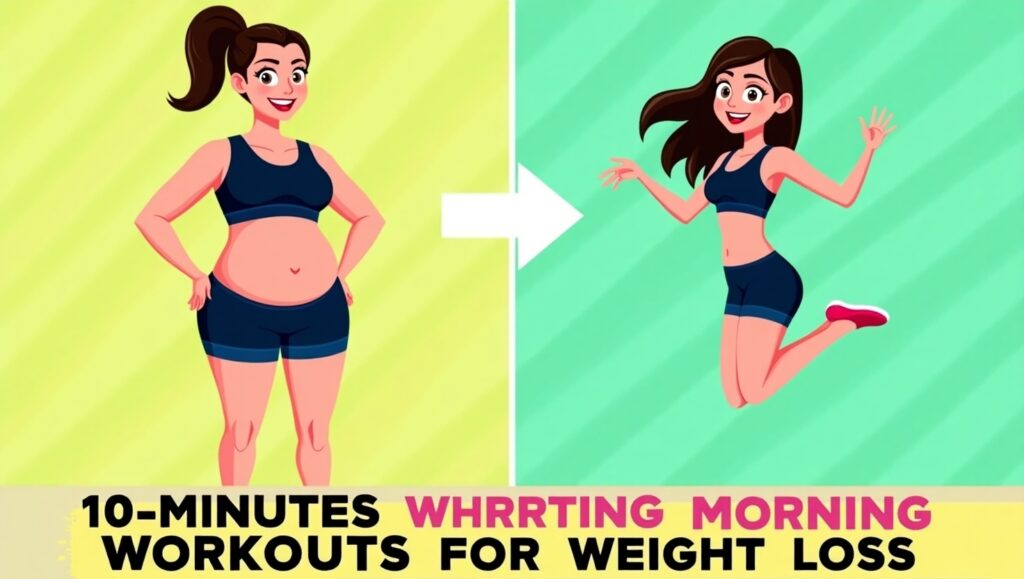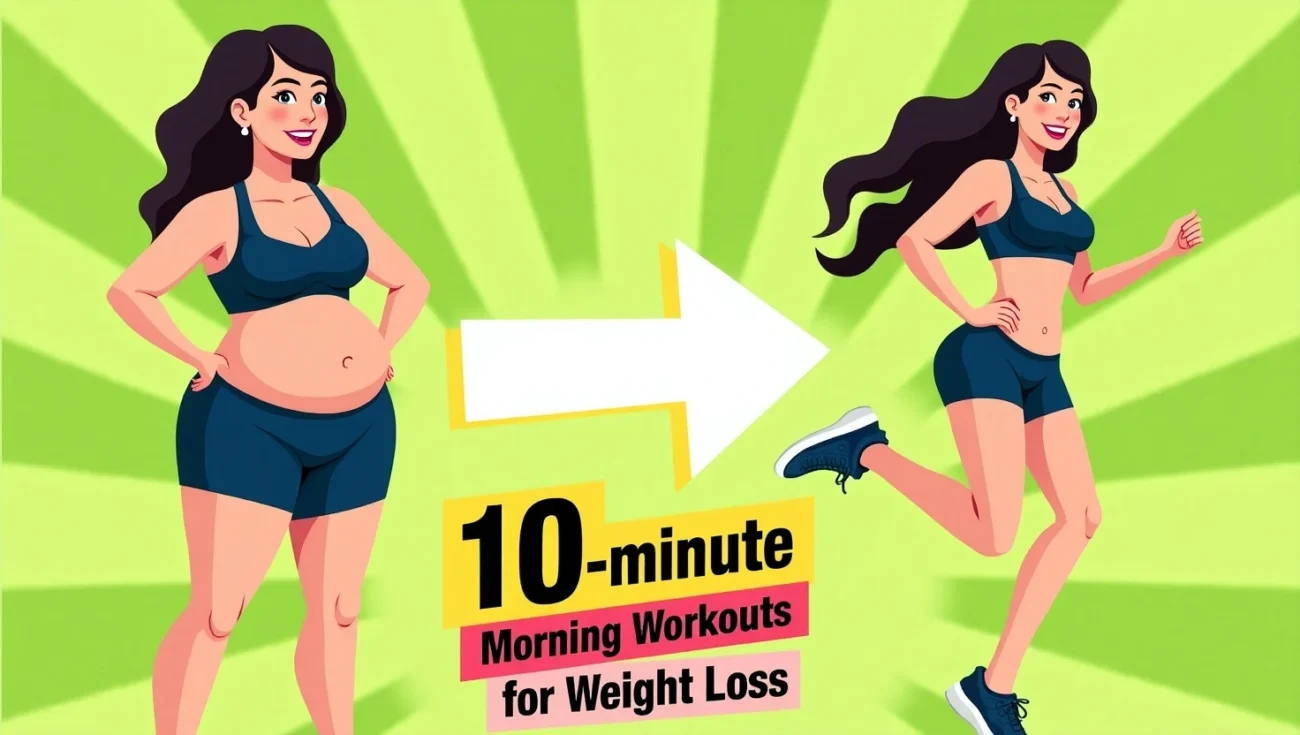Starting your day with a quick, effective, and sustainable morning workouts can transform your routine. Busy individuals are increasingly turning to short, high-impact exercises to boost energy and kickstart their metabolism. A well-structured 10-minute workout not only warms up your joints but also activates multiple muscle groups, making it an efficient way to prepare for the day ahead.
Lindsey Bomgren’s 10-minute bodyweight workout is a prime example of how short sessions can deliver significant benefits. Her approach focuses on compound exercises that enhance mobility, reduce stress, and provide a metabolic boost—no equipment needed. Whether you’re at home, in a hotel, or outdoors, these routines adapt to any setting, making fitness accessible to everyone.
By incorporating a structured morning workout, you set a positive tone for the day. This article will guide you through the benefits of these routines, specific exercises, and expert tips to maximize your results. Get ready to embrace a healthier lifestyle with minimal time investment.
• A 10-minute morning workout can significantly improve energy and metabolism.
• Bodyweight exercises offer a convenient and effective fitness solution.
• Consistency in short workouts leads to noticeable long-term benefits.
Benefits of a Quick Morning Workouts
Starting your day with a quick morning workout offers a wide range of benefits that extend beyond just physical health. It’s a powerful way to kickstart your metabolism and set a positive tone for the day. By incorporating a short exercise routine into your morning, you can experience both physiological and mental improvements that last throughout the day.
Boosted Metabolism and Energy
Exercise in the morning jumpstarts your metabolism, helping your body burn calories more efficiently throughout the day. This metabolic boost is especially beneficial for those looking to manage their weight and improve overall energy levels. Studies show that morning workouts can increase your resting metabolic rate (RMR), which means your body continues to burn calories even after the exercise is done.
Stress Reduction and Improved Focus
A morning workout also has mental benefits. It reduces stress by lowering cortisol levels and releasing endorphins, which create a sense of well-being. Many people find that exercising in the morning improves their focus and mental clarity, making it easier to tackle daily tasks. Lindsey Bomgren’s 10-minute bodyweight workout is a great example of how short sessions can make a big difference in both body and mind.
These benefits are backed by research and real-life experiences. A quick morning workout not only prepares your body for the day but also enhances your mental state. Whether you’re looking to boost energy, reduce stress, or simply feel more prepared, a short morning exercise routine can be a game-changer.
Read More: Best exercises to target lower belly fat
10-Minute Morning Workouts for weight loss
A well-structured circuit of compound movements forms the backbone of effective 10-minute morning workouts. These exercises are designed to target multiple muscle groups simultaneously, enhancing both functional performance and metabolic efficiency.
Lindsey Bomgren’s routine exemplifies this approach, utilizing 10 compound bodyweight movements. Each exercise serves dual purposes: as a warm-up to prepare the body and as a strength-building activity to engage muscles. This dual functionality makes the workout efficient and time-effective.
Compound movements, such as squats and lunges, work several muscle groups at once, boosting metabolic rate and fortifying muscles used in daily activities. Performing these exercises back-to-back with minimal rest keeps the heart rate elevated, maximizing calorie burn and lean muscle development.
This format is ideal for weight loss as it rapidly burns calories while building strength. It’s also versatile, catering to both beginners and advanced fitness enthusiasts through modifications. Whether you’re just starting or looking to intensify your routine, this approach ensures consistent progress and engagement.
Simple Bodyweight Movements to Get Started

Starting your day with simple bodyweight exercises is an excellent way to build strength and improve mobility. These movements are perfect for all fitness levels and require no equipment, making them ideal for any setting.
Dynamic Warm-Up Techniques
A dynamic warm-up prepares your body for exercise by increasing blood flow and reducing stiffness. Here are some effective techniques:
- Air squats: Stand with feet shoulder-width apart, then squat down, keeping your chest up.
- Arm circles: Extend your arms out and make small circles forward and backward.
- Leg swings: Stand and swing one leg forward and backward, then switch.
These movements are low-impact and great for beginners, helping to minimize injury risk.
Read More: How to lose belly fat without dieting
Effective Compound Exercises
Compound exercises work multiple muscle groups at once, making your workout efficient. Try these:
- Push-ups: Works the chest, shoulders, and core. Modify on knees if needed.
- Lunges: Targets legs and glutes. Step forward and lower until both knees are bent at 90 degrees.
These exercises improve balance and strength, essential for daily activities. They can be scaled to suit your fitness level, ensuring consistent progress.
By incorporating these simple bodyweight movements into your morning routine, you can enhance mobility and build strength without equipment. Whether you’re a beginner or advanced, these exercises offer a balanced approach to fitness.
Maximizing Mobility and Flexibility in the Morning
Incorporating flexibility exercises into your morning routine can significantly enhance your overall fitness journey. Yoga and stretching routines are powerful tools that not only improve mobility but also complement strength-building workouts.
Yoga and Stretch Routines
Yoga and stretching are essential for maintaining flexibility and preventing injuries. These practices focus on elongating muscles, improving joint mobility, and enhancing circulation. By incorporating these into your morning, you prepare your body for more intense activities later in the day.
- Downward Dog: Stretches the hamstrings and calves while strengthening the shoulders.
- Seated Forward Fold: Targets the lower back and hips, promoting relaxation.
- Dynamic Stretches: Movements like arm circles and leg swings activate muscles and boost blood flow.
These exercises not only aid in muscle recovery but also improve posture and reduce injury risk. Integrating mindful movement can increase relaxation and focus, setting a positive tone for the day.
By adding yoga and stretching to your morning workout, you enhance your body’s flexibility and prepare it for strength training. This balanced approach ensures a well-rounded fitness routine that supports long-term health and mobility.
Fueling and Preparing Your Body
Proper nutrition plays a vital role in maximizing the benefits of your morning workout. A well-fueled body ensures you have the energy to power through your routine and supports recovery.
Pre-Workout Nutrition Insights
A light, balanced meal consumed 30-60 minutes before exercise is ideal. Options like whole-grain toast with avocado or a light protein smoothie provide sustained energy without causing discomfort.
Incorporate a mix of carbohydrates, proteins, and healthy fats to maintain energy levels. Even a small snack can enhance performance and aid recovery. Streamline your routine by preparing clothes and ingredients the night before.
Proper fueling helps optimize your workout’s effectiveness, ensuring you get the most out of your time and effort.
Read More: Cardio Exercises For Weight Loss At Home
Adapting Your Routine for Consistent Progress
Adapting your workout routine to suit your fitness level is key to maintaining progress and preventing plateaus. Whether you’re just starting out or looking to challenge yourself, adjusting the intensity and complexity of your exercises ensures continuous improvement. This approach keeps your workouts engaging and effective, regardless of your current fitness level.
Modifications for Beginners
If you’re new to morning workouts, start with simpler versions of exercises to build strength and confidence gradually. Here are some effective modifications:
- Push-Ups on Knees: Perform push-ups with your knees on the ground to reduce strain on your upper body.
- Bodyweight Squats: Focus on proper form with a partial range of motion to avoid strain on your joints.
These modifications help you build a strong foundation while minimizing the risk of injury.
Intensity Tips for Advanced Trainers
For those looking to increase the challenge, there are several ways to intensify your workout:
- Additional Reps: Increase the number of repetitions or sets to push your limits further.
- Shorter Rest Intervals: Reduce rest time between exercises to keep your heart rate elevated and boost cardiovascular benefits.
- Plyometric Movements: Add explosive movements like jump squats or burpees to increase intensity and engage more muscle groups.
These adjustments not only enhance the physical challenge but also keep your workouts dynamic and engaging.
Regular adaptation is crucial for consistent progress. By gradually increasing intensity or modifying exercises, you avoid plateaus and ensure your workouts remain challenging. Proper form should always be prioritized to prevent injuries, especially when increasing intensity. Consistency and gradual progression are key to achieving long-term improvements in strength, mobility, and overall fitness.
Incorporating Active Recovery and Rest
Rest and recovery are just as important as the workout itself. Giving your body time to heal ensures you can perform at your best and prevents burnout. Active recovery, like gentle stretching or light walking, keeps your blood flowing without overexerting your muscles.
Why Recovery Matters
Recovery days are essential for muscle repair and growth. They help reduce muscle soreness and improve flexibility. Even a short walk or some light yoga can make a big difference in how you feel.
- Gentle Yoga: Helps with flexibility and relaxation.
- Foam Rolling: Reduces muscle tension and improves circulation.
- Brisk Walking: Keeps you moving without straining your body.
Listening to your body is key. If you’re feeling tired or sore, it’s a sign you need to rest. This helps prevent injuries and keeps your workouts effective. Recovery days support long-term progress, so make them part of your routine.
Conclusion
Embracing a quick morning workout can transform your daily routine and set the stage for a healthier lifestyle. By dedicating just a few minutes each day to simple bodyweight exercises, you can experience a significant boost in metabolism, enhanced mental clarity, and improved overall fitness.
The combination of compound movements and dynamic stretches not only burns calories but also strengthens your muscles and enhances mobility. Consistency is key—regular practice of these exercises can lead to noticeable weight loss and improved physical conditioning.
Remember, it’s all about balance. Pair your workout with proper nutrition and active recovery to support your progress. Whether you’re a beginner or an advanced fitness enthusiast, modifying the routine to suit your needs ensures sustained growth and engagement.
So, rise early, get moving, and start your day with renewed energy and focus. Consistency in these brief yet effective workouts can lead to lasting positive changes in your health and well-being.
FAQ
How can I incorporate core exercises into my morning routine?
Start with planks, which engage your core muscles effectively. Hold a plank for 20-30 seconds, rest for 10 seconds, and repeat for 3-4 sets. You can also add dynamic movements like bicycle crunches or leg raises to target different core areas.
What are the best compound movements for a quick morning workout?
Squats, lunges, and push-ups are excellent compound exercises. They work multiple muscle groups at once, making your workout efficient. Aim for 3 sets of 10-12 reps for each exercise to build strength and endurance.
How do I improve my balance and mobility during a morning workout?
Incorporate single-leg squats and balance poses like tree pose from yoga. These exercises challenge your stability and enhance mobility. Start with shorter holds and gradually increase as your balance improves.
What should I eat before a morning workout to fuel my body?
Keep it light with a banana, a handful of nuts, or a protein smoothie 30-45 minutes before exercising. Avoid heavy meals to prevent discomfort during your workout.
Can I modify exercises if I’m a beginner or dealing with an injury?
Absolutely. For example, replace push-ups with knee push-ups or use a chair for support. If you have a knee injury, swap lunges for seated leg extensions. Always prioritize form and comfort to prevent further injury.
How often should I rest to allow my muscles to recover?
Aim for at least one or two rest days a week. On these days, consider active recovery like light yoga or stretching to maintain mobility without straining your muscles.
What are the benefits of starting my day with a morning workout?
Morning workouts can boost your metabolism, increase energy levels, and improve mental clarity. They also set a positive tone for the rest of your day, helping you stay focused and motivated.
How can I track my progress and stay motivated?
Use a workout journal to log your exercises, reps, and sets. Celebrate small victories, like increasing your squat depth or holding a plank longer. Sharing your progress with a friend can also keep you accountable and motivated.

